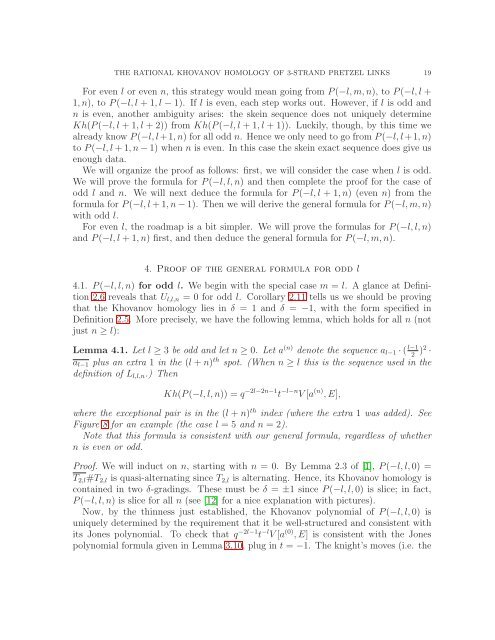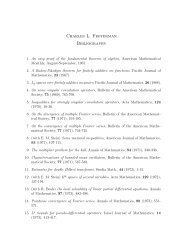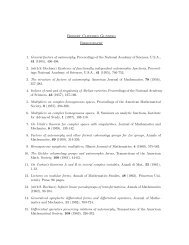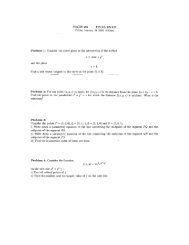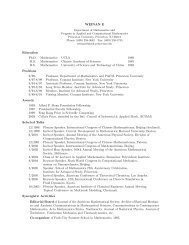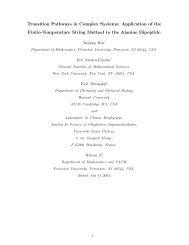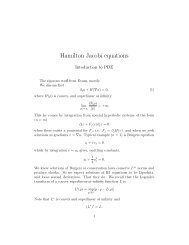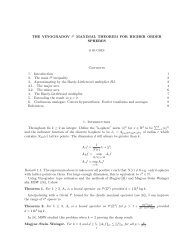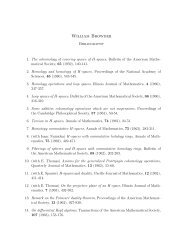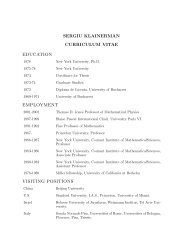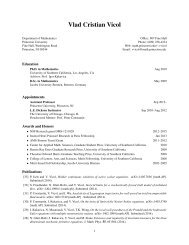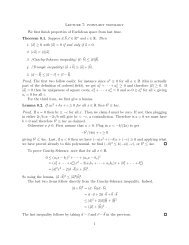The rational Khovanov homology of 3-strand pretzel links
The rational Khovanov homology of 3-strand pretzel links
The rational Khovanov homology of 3-strand pretzel links
You also want an ePaper? Increase the reach of your titles
YUMPU automatically turns print PDFs into web optimized ePapers that Google loves.
THE RATIONAL KHOVANOV HOMOLOGY OF 3-STRAND PRETZEL LINKS 19<br />
For even l or even n, this strategy would mean going from P(−l,m,n), to P(−l,l +<br />
1,n), to P(−l,l + 1,l − 1). If l is even, each step works out. However, if l is odd and<br />
n is even, another ambiguity arises: the skein sequence does not uniquely determine<br />
Kh(P(−l,l + 1,l + 2)) from Kh(P(−l,l + 1,l + 1)). Luckily, though, by this time we<br />
already know P(−l,l+1,n) for all odd n. Hence we only need to go from P(−l,l+1,n)<br />
to P(−l,l + 1,n − 1) when n is even. In this case the skein exact sequence does give us<br />
enough data.<br />
We will organize the pro<strong>of</strong> as follows: first, we will consider the case when l is odd.<br />
We will prove the formula for P(−l,l,n) and then complete the pro<strong>of</strong> for the case <strong>of</strong><br />
odd l and n. We will next deduce the formula for P(−l,l + 1,n) (even n) from the<br />
formula for P(−l,l + 1,n − 1). <strong>The</strong>n we will derive the general formula for P(−l,m,n)<br />
with odd l.<br />
For even l, the roadmap is a bit simpler. We will prove the formulas for P(−l,l,n)<br />
and P(−l,l + 1,n) first, and then deduce the general formula for P(−l,m,n).<br />
4. Pro<strong>of</strong> <strong>of</strong> the general formula for odd l<br />
4.1. P(−l,l,n) for odd l. We begin with the special case m = l. A glance at Definition<br />
2.6 reveals that U l,l,n = 0 for odd l. Corollary 2.11 tells us we should be proving<br />
that the <strong>Khovanov</strong> <strong>homology</strong> lies in δ = 1 and δ = −1, with the form specified in<br />
Definition 2.5. More precisely, we have the following lemma, which holds for all n (not<br />
just n ≥ l):<br />
Lemma 4.1. Let l ≥ 3 be odd and let n ≥ 0. Let a (n) denote the sequence a l−1 · ( l−1<br />
2 )2 ·<br />
a l−1 plus an extra 1 in the (l + n) th spot. (When n ≥ l this is the sequence used in the<br />
definition <strong>of</strong> L l,l,n .) <strong>The</strong>n<br />
Kh(P(−l,l,n)) = q −2l−2n−1 t −l−n V [a (n) ,E],<br />
where the exceptional pair is in the (l + n) th index (where the extra 1 was added). See<br />
Figure 8 for an example (the case l = 5 and n = 2).<br />
Note that this formula is consistent with our general formula, regardless <strong>of</strong> whether<br />
n is even or odd.<br />
Pro<strong>of</strong>. We will induct on n, starting with n = 0. By Lemma 2.3 <strong>of</strong> [1], P(−l,l, 0) =<br />
T 2,l #T 2,l is quasi-alternating since T 2,l is alternating. Hence, its <strong>Khovanov</strong> <strong>homology</strong> is<br />
contained in two δ-gradings. <strong>The</strong>se must be δ = ±1 since P(−l,l, 0) is slice; in fact,<br />
P(−l,l,n) is slice for all n (see [12] for a nice explanation with pictures).<br />
Now, by the thinness just established, the <strong>Khovanov</strong> polynomial <strong>of</strong> P(−l,l, 0) is<br />
uniquely determined by the requirement that it be well-structured and consistent with<br />
its Jones polynomial. To check that q −2l−1 t −l V [a (0) ,E] is consistent with the Jones<br />
polynomial formula given in Lemma 3.10, plug in t = −1. <strong>The</strong> knight’s moves (i.e. the


